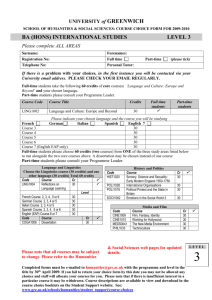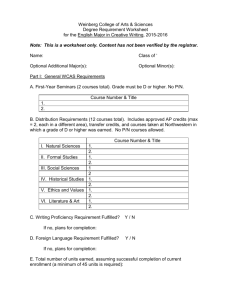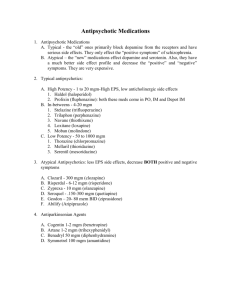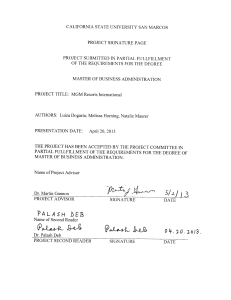How Do Proposed General Education Goals Mesh with Current
advertisement
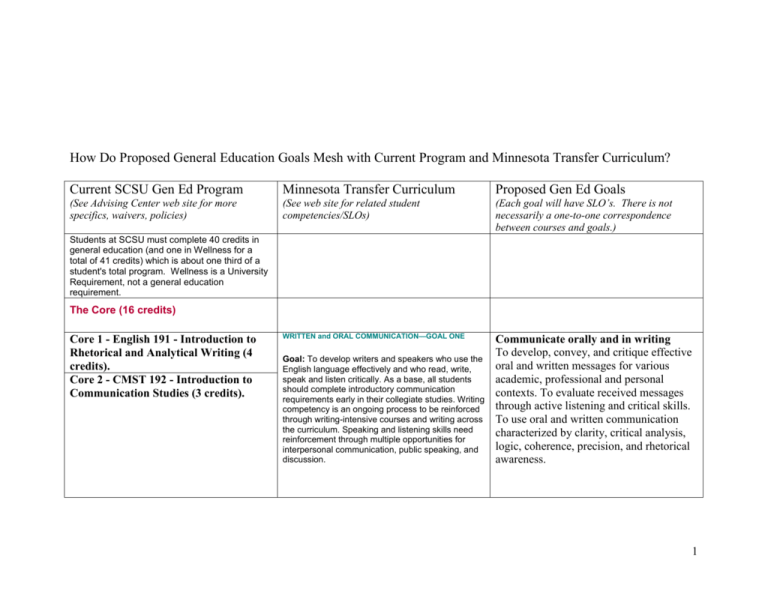
How Do Proposed General Education Goals Mesh with Current Program and Minnesota Transfer Curriculum? Current SCSU Gen Ed Program Minnesota Transfer Curriculum Proposed Gen Ed Goals (See Advising Center web site for more specifics, waivers, policies) (See web site for related student competencies/SLOs) (Each goal will have SLO’s. There is not necessarily a one-to-one correspondence between courses and goals.) WRITTEN and ORAL COMMUNICATION—GOAL ONE Communicate orally and in writing To develop, convey, and critique effective oral and written messages for various academic, professional and personal contexts. To evaluate received messages through active listening and critical skills. To use oral and written communication characterized by clarity, critical analysis, logic, coherence, precision, and rhetorical awareness. Students at SCSU must complete 40 credits in general education (and one in Wellness for a total of 41 credits) which is about one third of a student's total program. Wellness is a University Requirement, not a general education requirement. The Core (16 credits) Core 1 - English 191 - Introduction to Rhetorical and Analytical Writing (4 credits). Core 2 - CMST 192 - Introduction to Communication Studies (3 credits). Goal: To develop writers and speakers who use the English language effectively and who read, write, speak and listen critically. As a base, all students should complete introductory communication requirements early in their collegiate studies. Writing competency is an ongoing process to be reinforced through writing-intensive courses and writing across the curriculum. Speaking and listening skills need reinforcement through multiple opportunities for interpersonal communication, public speaking, and discussion. 1 Core 3 - Math/Stat 193 Mathematical/Statistical Thinking (3 credits). MATHEMATICAL / SYMBOLIC SYSTEMS—GOAL FOUR Core 4 - Philosophy 194 - Critical Reasoning (3 credits). CRITICAL THINKING—GOAL TWO Goal: To increase students’ knowledge about mathematical and logical modes of thinking. This will enable students to appreciate the breadth of applications of mathematics, evaluate arguments, and detect fallacious reasoning. Students will learn to apply mathematics, logic, and/or statistics to help them make decisions in their lives and careers. Minnesota's public higher education systems have agreed that developmental mathematics includes the first three years of a high school mathematics sequence through intermediate algebra. Goal: To develop thinkers who are able to unify factual, creative, rational, and value-sensitive modes of thought. Critical thinking will be taught and used throughout the general education curriculum in order to develop students’ awareness of their own thinking and problem-solving procedures. To integrate new skills into their customary ways of thinking, students must be actively engaged in practicing thinking skills and applying them to openended problems. Understand mathematical techniques and reason quantitatively To develop an understanding of mathematical techniques and to reason quantitatively. The discipline of mathematics focuses on the study of number and numerical relationships, and analyzes the underlying quantitative order and patterns of the natural and cultural worlds. Identify, analyze and critically evaluate reasoning To improve the ability of students to reason well. Critical reasoning includes identifying reasoning, analyzing reasoning and learning how it works, and distinguishing good reasoning from bad. It is thus essentially evaluative. 2 Core 5 - Democratic Citizenship (3 credits). ETHICAL AND CIVIC RESPONSIBILITY—GOAL NINE Goal: To develop students' capacity to identify, discuss, and reflect upon the ethical dimensions of political, social, and personal life and to understand the ways in which they can exercise responsible and productive citizenship. While there are diverse views of social justice or the common good in a pluralistic society, students should learn that responsible citizenship requires them to develop skills to understand their own and other's positions, be part of the free exchange of ideas, and function as public-minded citizens. Civic Engagement To provide the knowledge and skills required to understand the multiple facets of effective citizenship. And, to provide opportunities to practice skills of active citizenship that foster competence and efficacy as students learn to monitor and influence public policy decisions. Distribution (24 Credits) Area A: Humanities and Fine Arts The Humanities--the Arts, Literature, and Philosophy—GOAL SIX Goal: To expand students’ knowledge of the human condition and human cultures. especially in relation to behavior, ideas, and values expressed in works of human imagination and thought. Through study in disciplines such as literature, philosophy, and the fine arts, students will engage in critical analysis, form aesthetic judgments, and develop an appreciation of the arts and humanities as fundamental to the health and survival of any society. Students should have experiences in both the arts and humanities. Understand and appreciate modes of human expression, systems of thought, and production and performance of meaning (Humanities) To expand students’ understanding and appreciation of modes of human expression and systems of thought, and to foster their abilities in the production and performance of meaning. Study of the humanities includes developing creativity and symbolic understanding, and contributing to the construction of the cultural life of our communities. 3 Area B: Natural Sciences NATURAL SCIENCES—GOAL THREE Goals: To improve students’ understanding of natural science principles and of the methods of scientific inquiry, i.e., the ways in which scientists investigate natural science phenomena. As a basis for lifelong learning, students need to know the vocabulary of science and to realize that while a set of principles has been developed through the work of previous scientists, ongoing scientific inquiry and new knowledge will bring changes in some of the ways scientists view the world. By studying the problems that engage today’s scientists, students learn to appreciate the importance of science in their lives and to understand the value of a scientific perspective. Students should be encouraged to study both the biological and physical sciences. Area C: Social and Behavioral Sciences HISTORY AND THE SOCIAL AND BEHAVIORAL SCIENCES—GOAL FIVE Goal: To increase students’ knowledge of how historians and social and behavioral scientists discover, describe, and explain the behaviors and interactions among individuals, groups, institutions. events, and ideas. Such knowledge will better equip students to understand themselves and the roles they play in addressing the issues facing humanity. Reason scientifically & understand the natural world To foster an understanding of physical and/or life sciences. To explore scientific principles, processes, limitations, and methods of inquiry. To discover knowledge by formulating hypotheses and testing them with observations and experimentation. Discover and understand social and historical structures of human societies To examine theoretical frameworks, analytical tools, and factual resources for understanding the social and historical structures of human societies. 4 Diversity (MGM) Students are required to take three Diversity (MGM) courses from three different departments. Courses that fulfill this requirement are marked in bold face and underlined on the General Education Check List. They are also listed at the end of that document by course, in alphabetical order. This is a university requirement, not a general education requirement. Students can take the Diversity (MGM) courses in general education, or in a major, minor, or as university elective. However, the Diversity (MGM) courses are all included in the general education program, and many students fulfill this requirement partly or completely through general education. One of the Diversity (MGM) courses must satisfy the Racial Issues requirement. HUMAN DIVERSITY—GOAL SEVEN Goal: To increase students' understanding of individual and group differences (e.g. race, gender, class) and their knowledge of the traditions and values of various groups in the United States. Students should be able to evaluate the United States' historical and contemporary responses to group differences. Note: Based on committee discussion on 5/5/06, this goal still needs some thought and refinement. The original goal is listed with the proposal to change following. We will address these at our first meeting in the Fall of 2006. Understand and respect values of a diverse society and a multicultural world Understand and respect values of a diverse society (alternative title?) Understanding the patterns of racial and ethnic inequality in the United States and fostering awareness about the heritage, culture, and contributions of racially subordinated groups, while engaging in selfreflection about how race and ethnic relations are embedded in the institutions that structure our lives. (Proposed wording is below. It was suggested that we might want to identify specifically racial and ethnic diversity. We will look at this goal vis-à-vis the goal of Demonstrate concern for individual worth and human rights below.) Understand and respect values of our diverse U.S. society To examine patterns of racial and ethnic inequality in the United States and foster awareness about the heritage, culture, and 5 contributions of racially subordinated groups, while engaging in self-reflection about how race and ethnic relations are embedded in the institutions that structure our lives. 6 GLOBAL PERSPECTIVE—GOAL EIGHT Goal: To increase students’ understanding of the growing interdependence of nations and peoples and develop their ability to apply a comparative perspective to cross-cultural social, economic and political experiences. Note: Based on committee discussion on 5/5/06, this goal still needs some thought and refinement. The original goal is listed with the proposal to change following. We will address these at our first meeting in the Fall of 2006. Approach issues from a global perspective Employing comparative knowledge to understand globalization, local and global connections, and to promote cultural exchanges, as well as to address global problems in such arenas as environmental change, economic development, world health, democracy, peace and security. Incorporating an examination of non-Western cultures of the world into global studies, such as Asia, Africa, Oceania, the Middle East, Latin America and the Caribbean. (Proposed wording is below. We did not get a chance to discuss this change.) Approach issues from a global perspective To employ comparative and interdisciplinary knowledge to gain an understanding about globalization, as well as local and global connections. To promote cultural exchanges, as well as to address global problems in such arenas as environmental change, economic 7 development, world health, democracy, peace and security. Global perspectives would include the study of non-Western cultures of the world, such as Asia, Africa, Oceania, the Middle East, Latin America and the Caribbean. 8 PEOPLE AND THE ENVIRONMENT—GOAL TEN Goal: To improve students' understanding of today's complex environmental challenges. Students will examine the inter-relatedness of human society and the natural environment. Knowledge of both bio-physical principles and socio-cultural systems is the foundation for integrative and critical thinking about environmental issues. Understand the inter-relatedness of humans and the natural environment To foster critical thinking about this relationship integrating bio-physical and socio-cultural perspectives. Integrative learning To connect skills and knowledge from multiple sources and experiences; to apply theory to practice in various settings; to utilize diverse and even contradictory points of view; and, to understand issues and positions contextually. [American Association of Colleges and Universities Statement on Integrative Learning] Collaborate with others To interdependently bring together diverse skills, knowledge and appreciative inquiry in order to achieve collective results and shared visions in complex environments and systems. 9 Use information literacy to gain understanding To develop student’s abilities to recognize when information is needed and have the ability to locate, evaluate, and use effectively the needed information. Information literacy includes determining the extent of information needed, accessing the needed information effectively and efficiently, evaluating information and its sources critically, incorporating selected information into one’s knowledge base , using information effectively to accomplish a specific purpose and understanding the economic, legal, and social issues surrounding the use of information, and accessing and using information ethically and legally 10 Note: Based on committee discussion on 5/5/06, this goal still needs some thought and refinement. The original goal is listed with the proposal to change following. We will address these at our first meeting in the Fall of 2006. Demonstrate concern for individual worth and human rights Promoting respect for human dignity and differences on local, national and global levels, through strengthening the cognitive, affective, and critical abilities of students by way of study, dialogue, and critical examinations of facts and beliefs. Fostering a sense of social responsibility and respect for persons across differences of nationality, religion, physical abilities, gender, sexual orientation, race and ethnicity. (Proposed wording is below. We discussed the possibility of either including a goal of ethics here or formulating a separate ethics goal.) Demonstrate concern for individual worth and human rights To promote respect for human dignity and differences on local, national and global levels, through strengthening the cognitive, affective, and critical abilities of students by way of study, dialogue, and critical examinations of facts and beliefs. To foster a sense of social responsibility and 11 respect for persons across differences of nationality, religion, physical abilities, gender, sexual orientation, race and ethnicity. 12




